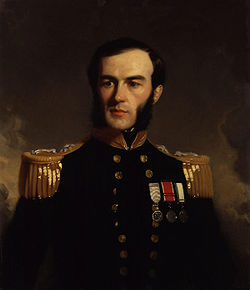Edward Augustus Inglefield
| Sir Edward Augustus Inglefield | |
|---|---|

Portrait by Stephen Pearce, 1853.
|
|
| Born |
27 March 1820 Cheltenham, England |
| Died | 4 September 1894 (aged 74) South Kensington, London, England |
| Buried at | Kensal Green Cemetery, London |
| Allegiance |
|
| Service/branch |
|
| Years of service | 1832 – 1885 |
| Rank | Admiral |
| Awards |
Knight Commander of the Order of the Bath Fellow of the Royal Society Fellow of the Royal Geographical Society |
Admiral Sir Edward Augustus Inglefield KCB FRS FRGS (27 March 1820 – 4 September 1894) was a Royal Naval officer who led one of the searches for the missing Arctic explorer John Franklin during the 1850s. In doing so, his expedition charted previously unexplored areas along the northern Canadian coastline, including Baffin Bay, Smith Sound and Lancaster Sound. He was also the inventor of the marine hydraulic steering gear and the anchor design that bears his name. The warship HMS Inglefield is named after him, as is the Inglefield Land region of Greenland and Inglefield Bay (Inglefieldbukta) on Spitsbergen, Norway.
Inglefield set out from Britain on his search in July 1852, commanding Lady Franklin's private steamer Isabel, seven years after Franklin had left on his ill-fated search for the fabled Northwest Passage. Once Inglefield had reached the Arctic, a search and survey of Greenland's west coast was made; Ellesmere Island was resighted and named in honour of the president of the Royal Geographical Society; Smith Sound was penetrated further than any known records; Jones Sound was also searched; and a landing was made at Beechey Island in Lancaster Sound. No sign, however, of Franklin's expedition was found. Finally, before the onset of winter forced Inglefield to turn homewards, the expedition searched and charted much of Baffin Island's eastern coast.
...
Wikipedia
